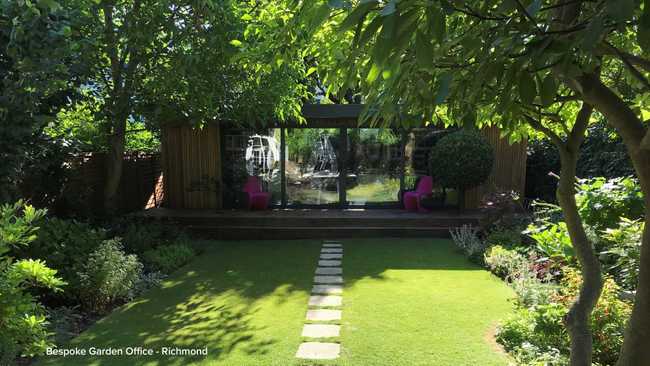Creative Inspiration and the Working Holiday
Creative inspiration in a working holiday came to Dan Sefton, TV writer, while he stayed at Kalukanda House. Dan is the writer of popular TV drama 'Good Karma Hospital' and he shared his time writing the show while staying with us in this article here
Can a working holiday really be productive? How can a garden office lead to such inspiration? Why does being in nature spark ideas? How does being mindful in a garden space deliver the goods when we have writers block or we need to find a solution to a problem?
Charles Leon, Designer, Writer and Past President of British Institute of Interior Design shares this article on how a Garden Office can be your creative hub.
The Garden Office - a creative hub
Author: Charles Leon
We have always known that our environments affect how we feel and that when we feel good our ability to focus and think creatively is increased. Colour, light, views, sound, and atmosphere all have a profound effect on how we feel. Healthy environments have a direct effect on our physical wellbeing and, as a result, our attitude becomes more positive, and our productivity increases.
“We shape our buildings and afterwards our buildings shape us” ~ Winston Churchill
We used to run a thriving design studio in Chiswick with sixteen designers working in an industrial unit. We built our garden offices and the quality of our lives improved by a factor of ten. Less commuting, more time around home and beautiful views of the garden.
Environmental psychology, which studies how the built or natural environment affects how we think, feel and act, back up what we, as designers, knew intuitively.
Views
In 1984, Roger S Ulrich, studied the relationship of surroundings to experience by looking into patient recovery in Paoli Hospital. The subjects were all in similar rooms, the only difference being that some had windows that looked out to trees and the others looked onto a brick wall.
Those patients that had views of green leaves and sky, rather than brick walls, recovered faster, had fewer complications and needed less medication. Their environment had a measurable effect on their physiognomy. The environment stimulated a tangible benefit which changed not only the physical but also the mental wellbeing of patients and improved recovery rates.
Colour
There is a connection between the control of our physical environment and improvements in wellbeing. Colour plays a vital role. Seeing natural colours as the garden blossoms and changes with the seasons enhance creative thinking. In 2009, Zhu and Mehta of the University of British Columbia carried out a study to measure the effect of colour on two styles of thinking; Analytical: logical, linear and objective thinking and Creative: intuitive, abstract and subjective thinking.
They gave the test group various tasks which were on paper with either a Blue, a Red or a White border on it. The white border acted as a “control group”. The tasks were the same in all three.
What they found was that those tasks which had had a blue border engendered more creative answers than those with a red border, which performed better where analysis and logic were required.
Our mental, idea space expands and contracts in direct proportion to our perception of physical space. The more open and expansive we perceive our space to be (the cooler colours, including Blues and Greens), the more open we are to new ideas. Conversely, the more constrained (the warmer colours, including Reds and Yellows) we perceive our space, the more focused and analytical our thinking becomes.
In 2006 Shashi Caan ran an experiment at a Design Trade show in New York with colourized event tents to study how people behaved when saturated by colour. In the blue space, people tended to gather towards the perimeter of the space in groups, as if being pulled outwards. In the red space, people tended to converge towards the centre of the tent as if the walls were pushing them in.
And that’s what studies have shown; we are at our creative peak when the light outside is in the blue range. So, most of us would be at our most creative during the morning.
Rooms with a View
The sensation of space and volume also has a measurable effect on people’s behaviour. In 2010 McCoy and Evans conducted an experiment where they got students (it’s always students) to take an exam in a room with a high ceiling and a low, suspended ceiling. The perception of 3D volume affected those who were in the high ceiling spaces performed better on the creative tasks, whereas those who were in the lower ceiling room performed better on the analytical tasks.
This holds also for spaces that have a view to the outside, rooms with a view were better for creative pursuits than those with no view. This confirms the connection between perceived mental space and physical space.
Circadian Rhythms and Lighting
Lighting has a powerful effect on our feelings of wellbeing and behaviour. In our garden office, because we have so much natural light, we feel less tired and more energised. Optimum levels of lighting are essential for creative and analytical thinking.
Daylight Colour temperature changes throughout the day from cooler tones early in the day to warmer tones during the evening. This sequence is known as the Circadian cycle and controls a lot of our natural body rhythms from muscle strength, energy levels, to sleep/wake patterns and our creativity. When we respect our natural circadian rhythms we can concentrate better in the daytime and sleep better in the nighttime.
This is where a garden office truly comes into its own. Better contact with the daily cycle will mean a better quality of life.
Nature, The Brain, & Neurogenesis
There have been many studies on the effect of stimulating environments and what is called “neurogenesis”, the production and retention of new neurons (brain cells). Until recently it was thought that you had all the brain cells you were ever going to have by the time you were in your early 20s and that it was all downhill from there. Not so, a Stanford University study proved that the quality of your environment, your sleep and your nutrition will have a significant effect on your ability to create and retain new neurons. The key here is “stimulation”. As with the study on recovering patients and the views they had, natural environments create a better sense of well-being, which translates directly into better cognitive skills. What we see and experience, particularly in nature, will manifest in our ability to solve problems.
Stress is one of the major causes of depression. Stress increases cortisol in the brain and body which increases inflammation and cognitive decline. The natural environment has been shown to reduce stress and therefore reduce the amount of cortisol produced which then reduces inflammation and allows better neurogenesis.
The conclusion, which comes as no surprise to most of us, is that a natural environment is good for you and helps to promote a sense of wellbeing, both mental and physical. The key though is stimulation; learning new things, immersing yourself in different cultures is all food for the brain and for the body.
Professional Designers understand how people behave, how they are affected by different stimuli and design spaces that optimise environments. The benefits of working from a garden office are almost incalculable. We transformed how we work and how we live… but I didn’t need science to tell me that!
About Charles Leon
Charles trained as a theatre set designer and began his professional career working for the National Theatre and the English National Opera, this led naturally into designing for film. In 1989, Charles was invited to join the UK’s foremost international hotel design company where he remained for five years.
In 1994, Charles established his own design practice, CLA. Working mostly with entrepreneurs and hotel developers. In 2010 he was joined by Nicholas Black and in 2014 they formed the design partnership Leon Black.
Leon Black are an Internationally acclaimed, award-winning design consultancy, that specialise in hotel, residential design and innovative thinking. Charles also lectures internationally on interface between design, neuroscience, economics, politics, philosophy, sociology, innovation, emotion and the workings of the designer’s mind. His talks provide a new, powerful and persuasive way of understanding why we think the way we do.
Charles is Past President of the BIID (British Institute of Interior Design), sit on the All Party Parliamentary Design and Innovation Committee and is guest lecturer at various design schools including Middlesex University, KLC, Inchbald and the Interior Design School.
Charles Leon https://www.charlesleon.uk
Recent Posts
- Detox and Beauty Balms Using Coconut Oil May 2025
- Selyn Textiles Weaving A Fair FutureApril 2025
- Rehan Mudannayake Actor Director WriterApril 2025
- Rangi Fernando Embodying Change April 2025
- Revatha Shah on Indigenous CultureApril 2025
- The Conscious Travel FoundationMarch 2025
- White Lotus with Shalini PeirisMarch 2025
- An Audience with Ashok FerryMarch 2025
- Siobhan D'Almeida, audacious Sri Lankan returningMarch 2025
- Roma Wells, Irish-Sri Lankan BBC Travel PresenterMarch 2025
- ALKE Designs, Sri Lankan JewelleryMarch 2025
- Omaya and the philosophy of YogaMarch 2025
- Zaynab Zubair, Diaspora DiariesMarch 2025
- Irushi Tenekoon animating Minette De SilvaMarch 2025
- Shiromi Pinto uncovering Minette De SilvaMarch 2025
- Serena Burgess, Activist and YogiMarch 2025
- Mehala Ford, Sari Drape by a Fashion PRMarch 2025
- Megan Dhakshini, Sultry Stories and Fierce ExpressionMarch 2025
- Irstel Jansen, Passionate Social Entrepreneur April 2024
- HERA Project X Making an ImpactFebruary 2024
- Sara Alke Jewellery Designer September 2023
- Creative Inspiration and the Working Holiday June 2023
- Beat Anxiety with Yoga and BreathworkJune 2023
- Dee Gibson Founder of Kalukanda HouseJune 2023
- Piyumi's StoryFebruary 2022
- Kalukanda House : Emotional Design, definedSeptember 2020
- SeaSisters Empowering Women through surfingSeptember 2020
- Our Charity Partner - TFTJune 2020
- Marie Claire Photoshoot at Kalukanda HouseJune 2020
- Sound Bath to Enjoy at HomeMay 2020
- Top Tips for Bespoke Yoga Retreats March 2019
- Guest Blog by Dan Sefton, Writer (Good Karma Hospital)January 2019
- Building Kalukanda House the StoryJune 2018


